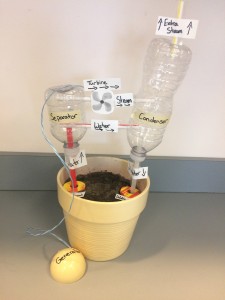The Life of a Genetic Mutation
Hello, my name is Ally, I am an Alzheimer’s gene. I am the most common form of dementia. One day I started killing the other cells in my host, Lexie’s brain. Over the past few months Lexie’s brain cells have started dying and her brain has started to shrink, the tissues now have fewer nerve cells and the connections between the nerve cells have weakened. Alzheimer’s develops deposits of protein and fibers that prevent the cells from working properly. When this happens, Lexie’s cells can’t send signals to other parts of her brain. She is slowly getting worse, she started forgetting little things and she is now starting to fully lose her memory. She will eventually develop severe mental problems and will have difficulties doing any daily activities. The doctors aren’t sure why I started killing Lexie’s brain cells but they always knew that there could be a possibility that she could develop Alzheimer’s because her uncle and her mom both died of early-onset Alzheimer’s Disease when they were in there mid fifty’s. Most people live 8 to 10 years after developing symptoms of my gene but some can live an even longer life, with many functional problems.
When she was 46 Lexie slowly started forgetting things, her car keys, relatives name or to turn her stove off. She also started having troubles speaking and putting her thoughts into words. Her doctor diagnosed her with early-onset Alzheimer’s Disease when she started to lose her sense of smell and when she forgot to turn of her stove for the second time and her kitchen nearly burned down. Lexie developed early-onset Alzheimer’s because her 21st chromosome is mutated. Mutations on chromosome 21 cause the formation of abnormal amyloid precursor proteins (APP).
Alzheimer’s disease is irreversible and currently there is no cure for this disease but there are treatments and medications that can help slow down the symptoms. Researchers continue to look for new treatments that could improve the quality of life even more for people with my gene of Alzheimer’s. 
The Making of Mutation Story
Ask: I asked myself how a normal gene becomes a mutated gene and how it causes Alzheimer’s. I also researched the different symptoms associated with Alzheimer’s and the affect it can have on the patient. As well as the affect that it has on the rest of their family. I researched both types of Alzheimer’s (early-onset and late-onset) in order to decide which one is best suited for my gene mutation and my host. I also learned some of the first signs that someone could be developing this disease and that there currently isn’t a cure for it.
Aquire: I used different websites to find the information I needed to answer the questions that I had. I used medical websites as well as kids learning websites to learn as much as I could about Alzheimer’s. I sited all the websites I used down below as well as the pictures I used. I also used pictures and diagrams to see how over time Alzheimer’s develops.
Analyze: I found relevant and accurate information that explained how Alzheimer’s works and develops in an easy to understand way. I cited all the websites and photos that I used.
Assess: I think the process went really well, I finished the assignment on time and I didn’t leave it to the last second. I learned a lot about Alzheimer’s that I didn’t know and I created a story that I think is fun and interesting. For next time I could have used even more photos to help me explain how Alzheimer’s develops and maybe even done a second story with a host that develops late on-set Alzheimer’s. I really enjoyed learning more about Alzheimer’s and had fun coming up with a story to go with my research.
Websites:
http://www.webmd.com/alzheimers/tc/alzheimers-disease-what-happens
https://www.nia.nih.gov/alzheimers/publication/alzheimers-disease-genetics-fact-sheet
http://www.alz.org/alzheimers_disease_treatments.asp
http://www.medicalnewstoday.com/articles/159442.php
https://kidshealth.org/en/kids/alzheimers.html
Pictures:
http://www.inifoundation.org/images/ALZ_Brain_Scan.jpg
http://www.crystalinks.com/alzheimersbrain.jpg



